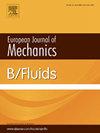双向相互作用假设对鼻腔喷雾模拟影响的实验与数值研究
IF 2.5
3区 工程技术
Q2 MECHANICS
引用次数: 0
摘要
使用鼻腔喷雾剂作为药物输送到鼻腔的方法是广泛的,因为他们的方便和有效的治疗各种条件。液滴从喷嘴流出的高速度会显著影响流场,导致沉积模式的变化。因此,了解液滴与流体之间的相互作用是至关重要的。在这项研究中,我们提出了一种创新和经济的方法来研究鼻喷雾剂中液滴和流体之间的双向相互作用。我们采用超高速摄影技术,使用极小的光脉冲来检查喷雾泡和提取液滴特性。我们的目的是确定双向相互作用假设是否在数值模型中产生显著差异。为了实现这一目标,我们首先测量了无约束环境条件下的液滴尺寸分布和喷雾锥角。然后,我们将测量扩展到实际尺寸的3D打印鼻通道模型,在各个部分截断,以分析液滴沉积如何在不同的鼻腔位置发生。我们还基于实测数据进行了瞬态数值模拟,以研究双向相互作用假设的重要性。并将数值模拟结果与实验结果进行了比较。实验结果与数值结果的对比表明,双向相互作用假设产生了显著差异,表明在鼻腔喷雾剂建模时必须考虑双向相互作用假设。综上所述,本研究结果对优化鼻腔喷雾剂的设计,提高药物给药到靶向部位的有效性具有重要意义。本文章由计算机程序翻译,如有差异,请以英文原文为准。
Experimental and numerical investigations on the impact of two-way interaction assumption in the nasal spray simulations
Using nasal sprays as a drug delivery method to the nasal cavity is widespread due to their convenience and effectiveness in treating various conditions. The high velocity of droplets exiting the nozzle can significantly impact the flow field, leading to changes in deposition patterns. Therefore, it is crucial to understand the interactions between the droplets and the fluid. In this research, we propose an innovative and cost-effective approach to investigate the two-way interactions between droplets and the fluid in numerical simulations of nasal sprays. We employ ultra-high-speed photography using an infinitesimal light pulse to examine spray puffs and extract droplet characteristics. We aim to determine whether the two-way interaction assumption produces significant differences in a numerical model. We first measured the droplet size distribution and spray cone angle in unconfined ambient conditions to achieve the objective. We then extended the measurement to real-sized 3D printed models of the nasal passage truncated in various sections to analyze how droplet deposition occurs in different nasal locations. We also conducted transient numerical simulations based on the measured data to investigate the importance of two-way interactions assumption. The results of the numerical simulations were then compared to the experimental results. Comparing the experimental and numerical results demonstrated that the two-way interaction assumption produced significant differences, indicating that it must be considered while modeling the nasal spray. Overall, this research's findings can significantly contribute to optimizing the design of nasal sprays and enhancing the effectiveness of drug delivery to the targeted location.
求助全文
通过发布文献求助,成功后即可免费获取论文全文。
去求助
来源期刊
CiteScore
5.90
自引率
3.80%
发文量
127
审稿时长
58 days
期刊介绍:
The European Journal of Mechanics - B/Fluids publishes papers in all fields of fluid mechanics. Although investigations in well-established areas are within the scope of the journal, recent developments and innovative ideas are particularly welcome. Theoretical, computational and experimental papers are equally welcome. Mathematical methods, be they deterministic or stochastic, analytical or numerical, will be accepted provided they serve to clarify some identifiable problems in fluid mechanics, and provided the significance of results is explained. Similarly, experimental papers must add physical insight in to the understanding of fluid mechanics.

 求助内容:
求助内容: 应助结果提醒方式:
应助结果提醒方式:


